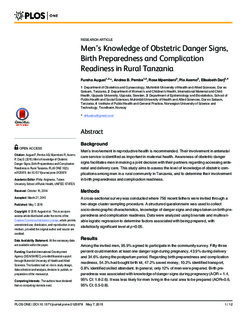| dc.contributor.author | August, Furaha | |
| dc.contributor.author | Pembe, Andrea | |
| dc.contributor.author | Mpembeni, Rose | |
| dc.contributor.author | Axemo, Pia | |
| dc.contributor.author | Darj, Elisabeth | |
| dc.date.accessioned | 2015-11-25T11:18:12Z | |
| dc.date.accessioned | 2016-01-05T15:28:21Z | |
| dc.date.available | 2015-11-25T11:18:12Z | |
| dc.date.available | 2016-01-05T15:28:21Z | |
| dc.date.issued | 2015 | |
| dc.identifier.citation | PLoS ONE 2015, 10(5) | nb_NO |
| dc.identifier.issn | 1932-6203 | |
| dc.identifier.uri | http://hdl.handle.net/11250/2372694 | |
| dc.description.abstract | Background:
Men’s involvement in reproductive health is recommended. Their involvement in antenatal care service is identified as important in maternal health. Awareness of obstetric danger signs facilitates men in making a joint decision with their partners regarding accessing antenatal and delivery care. This study aims to assess the level of knowledge of obstetric complications among men in a rural community in Tanzania, and to determine their involvement in birth preparedness and complication readiness.
Methods:
A cross-sectional survey was conducted where 756 recent fathers were invited through a two-stage cluster sampling procedure. A structured questionnaire was used to collect socio-demographic characteristics, knowledge of danger signs and steps taken on birth preparedness and complication readiness. Data were analyzed using bivariate and multivariable logistic regression to determine factors associated with being prepared, with statistically significant level at p<0.05.
Results:
Among the invited men, 95.9% agreed to participate in the community survey. Fifty-three percent could mention at least one danger sign during pregnancy, 43.9% during delivery and 34.6% during the postpartum period. Regarding birth preparedness and complication readiness, 54.3% had bought birth kit, 47.2% saved money, 10.2% identified transport, 0.8% identified skilled attendant. In general, only 12% of men were prepared. Birth preparedness was associated with knowledge of danger signs during pregnancy (AOR = 1.4, 95% CI: 1.8-2.6). It was less likely for men living in the rural area to be prepared (AOR=0.6, 95% CI; 0.5-0.8).
Conclusion:
There was a low level of knowledge of obstetric danger signs among men in a rural district in Tanzania. A very small proportion of men had prepared for childbirth and complication readiness. There was no effect of knowledge of danger signs during childbirth and postpartum period on being prepared. Innovative strategies that increase awareness of danger signs as well as birth preparedness and complication readiness among men are required. Strengthening counseling during antenatal care services that involve men together with partners is recommended. | nb_NO |
| dc.language.iso | eng | nb_NO |
| dc.publisher | Public Library of Science | nb_NO |
| dc.title | Men's Knowledge of Obstetric Danger Signs, Birth Preparedness and Complication Readiness in Rural Tanzania | nb_NO |
| dc.type | Journal article | nb_NO |
| dc.date.updated | 2015-11-25T11:18:11Z | |
| dc.source.volume | 10 | nb_NO |
| dc.source.journal | PLoS ONE | nb_NO |
| dc.source.issue | 5 | nb_NO |
| dc.identifier.doi | 10.1371/journal.pone.0125978 | |
| dc.identifier.cristin | 1241720 | |
| dc.description.localcode | © 2015 August et al. This is an open access article distributed under the terms of the Creative Commons Attribution License, which permits unrestricted use, distribution, and reproduction in any medium, provided the original author and source are credited. | nb_NO |
